
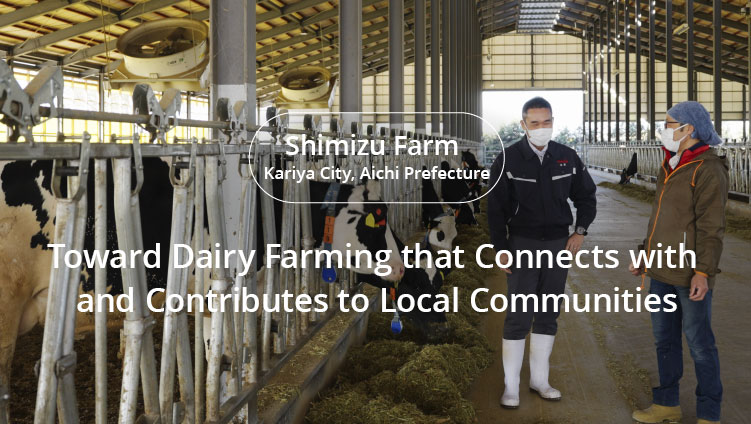
We will introduce Shimizu Farm in Kariya City, Aichi Prefecture, which participates in Meiji Dairy Advisory(MDA) initiative.
We interviewed Mr. Kazumasa Shimizu, who is actively communicating with the local community in order to create a farm where cows and farmers can live together like a family.
-
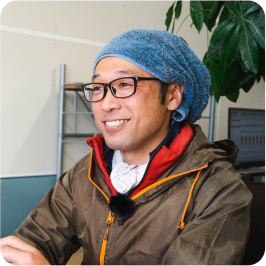
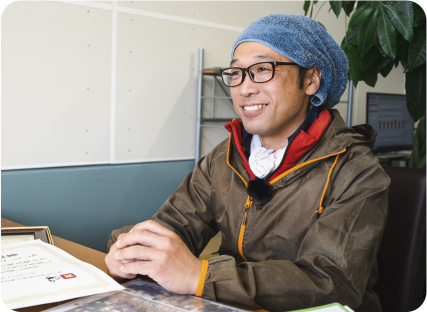
Kazumasa Shimizu
-


Relationships with local communities support the farm
Shimizu Farm is the only dairy farm in Kariya City, Aichi Prefecture. Four employees keep around 200 cows. An old irrigation canal runs next to the farm. Many local residents take walks along its sides, and in the afternoon, elementary school children sometimes come to visit play on the farm.
"In 2021, my father entrusted me with the management of the farm, and when I incorporated the farm, I formulated the management philosophy: Living together with cows, we contribute to the development of the community and its affluent lifestyle.
Since my grandfather's generation, we have basically raised our own cows from calves, so when a cow born here leaves the farm, it is either when it has finished its role as a dairy cow or when it dies.
Since the cows live with us for such a long time, we want to be kind to them and treat friendly and like family," says Mr. Shimizu, the president.
Behind the old cowshed, calves as young as one year old are playing and running around in the fence. Fun graffiti can be seen on a package of grass feed placed on the property. "The first cowshed my grandfather built here was an elementary school in town that was relocated, and the word "Gaku" which means school still remains on the devil's tile. Children from that elementary school come to visit the farm and play after school. The graffiti is like a message board for the children," says Mr. Shimizu with a smile.
-


Graffiti left on a package of grass feed by an elementary school student who came to visit. It contains messages that the children learned.
-
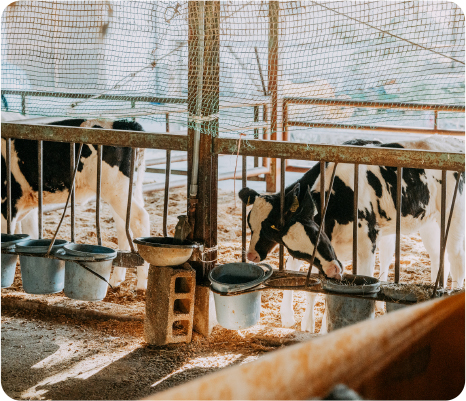

Calves 2-3 months old. They will spend their entire life on the farm.
-
Shimizu Farm asks farmers in the town to plant the rice (rice fermented roughage: rice whole-crop silage) that they feed to their cows. Within an hour's drive from Nagoya-shi, they have established a connection that allows them to obtain domestically produced feed.
"Originally, rice for cattle might be better, but we found it difficult to manage the rice fields. We harvest rice for human consumption at the right time for cows feed and use it as rice WCS. If it is harvested at the right time for human consumption, it can be used as staple food for humans. It's like we are sharing our emergency food with them, so to speak," says Mr. Shimizu.
In addition, the cattle manure from the farm is separated into solid-liquid and stored temporarily at a composting facility, and then given to rice WCS farmers and neighboring farmers as compost. The rice hulls used to cover the cows' beds is transported by Mr. Shimizu himself from a rice storage facility in the town. -
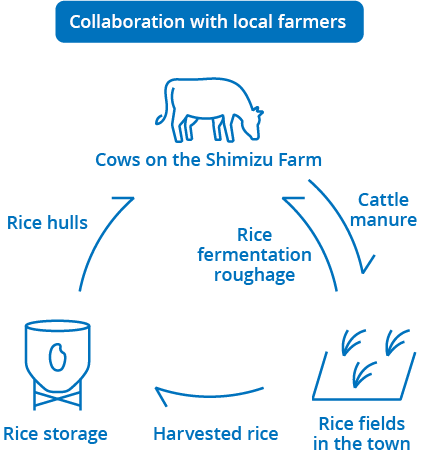

In connection with the local community, we also teach children about the cycle of resources in agriculture and the connection to life.
Since the farm is always busy with people coming and going from elementary school children to the elderly, the four employees are also accustomed to dealing with people, and they will continue milking as usual during the interview.
"The cowshed that anyone can visit means that consumers are close to us," says Mr. Shimizu. "We also try to keep the new cowshed clean so that people can think our milk safe and secure that is milked in a clean environment."
Challenge to update the farm
In June 2022, we completed a new free-stall cowshed that allows cows to move freely.
The current number of milking cows is 90, while the number of beds is for 176 cows. We are promoting a plan to increase the number of cows over the next few years.
The summer in Kariya-shi, Aichi Prefecture, is extremely hot. Therefore, a calculated ventilation system has been installed in the new cowshed, and eight large fans are in operation during the summer along with a breeze from the south.
Furthermore, the mats of the beds are filled with water, which, in addition to the softness of the waterbeds, provides comfort during hot weather because the coldness of the concrete is not blocked by the mats and is transmitted to the cows.
The milking parlor (milking facility) consists of two rows of eight cows, with two employees in charge of milking. "What we try to do is to milk the cows in a way that is less stressful for them, based on our philosophy of treating them kindly. And after using the milking parlor, we clean it carefully to return it to its original clean condition.
-

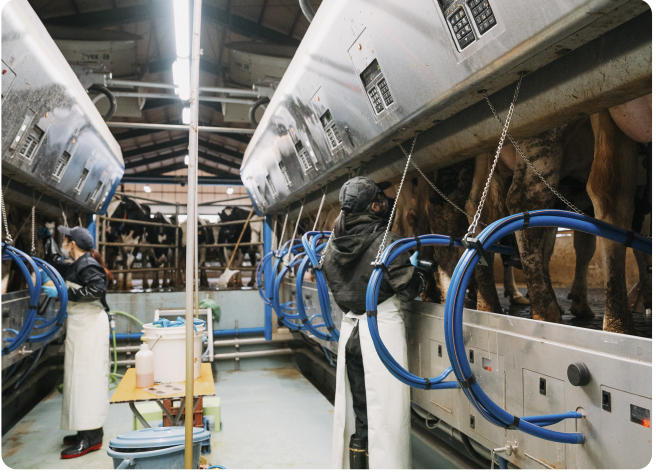
Work in the milking parlor.
Two months after the move, the cows are getting used to milking. -
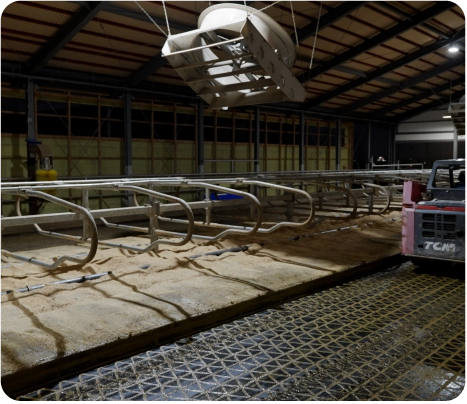

Rice hulls on waterbed improves comfort for cows.
Easier temperature control has significantly reduced disease in summer 2022.
After moving to the new cowshed, the work efficiency has increased, and the milk quality has improved dramatically.
A graph of somatic cell counts is posted in the control room next to the milking parlor.
"The somatic cell count graphs are prepared monthly by Meiji's staff, which helps to raise employee awareness. Since the comparison with the previous year was visualized at a glance, it gave us a chance to think about the causes of the ups and downs of the numbers," says Mr. Shimizu as results of MDA.
-
Finding the cause of the problem requires not only observation of the cows but also specialized knowledge, which he feels is difficult to pass on to his members.
"In the past, dairy farmers may have learned their jobs by watching the behavior and actions of their predecessors, but not anymore. By teaching cause-and-effect relationships at a level appropriate to their knowledge, we want our staff to develop the ability to search for solutions on their own," says Mr. Shimizu.
Staff from Meiji Feed, Meiji Animal Health, and Meiji check the condition of cows and feed, as well as the working conditions of employees. By indicating problems and improvement measures, they provide support in cooperation as the Meiji Group.
"Cows are sensitive animals. The move to the new cowshed also caused a great deal of stress, and their milk production dropped," says Mr. Shimizu. -


However, the environment is better than the old cowshed, and work efficiency has improved. Mr. Shimizu continues, "Now is the time to be patient as we work to increase the number of cows. Since the new barn was planned, we have switched to cows with strong legs that can be kept in the free-stall cowshed, and we expect to have 50-60 cows calving in the spring of 2023. Our goal is to have 176 cows in the new cowshed, while at the same time improving the efficiency of the old cowshed.
Shimizu Farm has been contributing to the community and deepening its connections. The challenge is still continuing to update the farm with new cowshed and cows.






